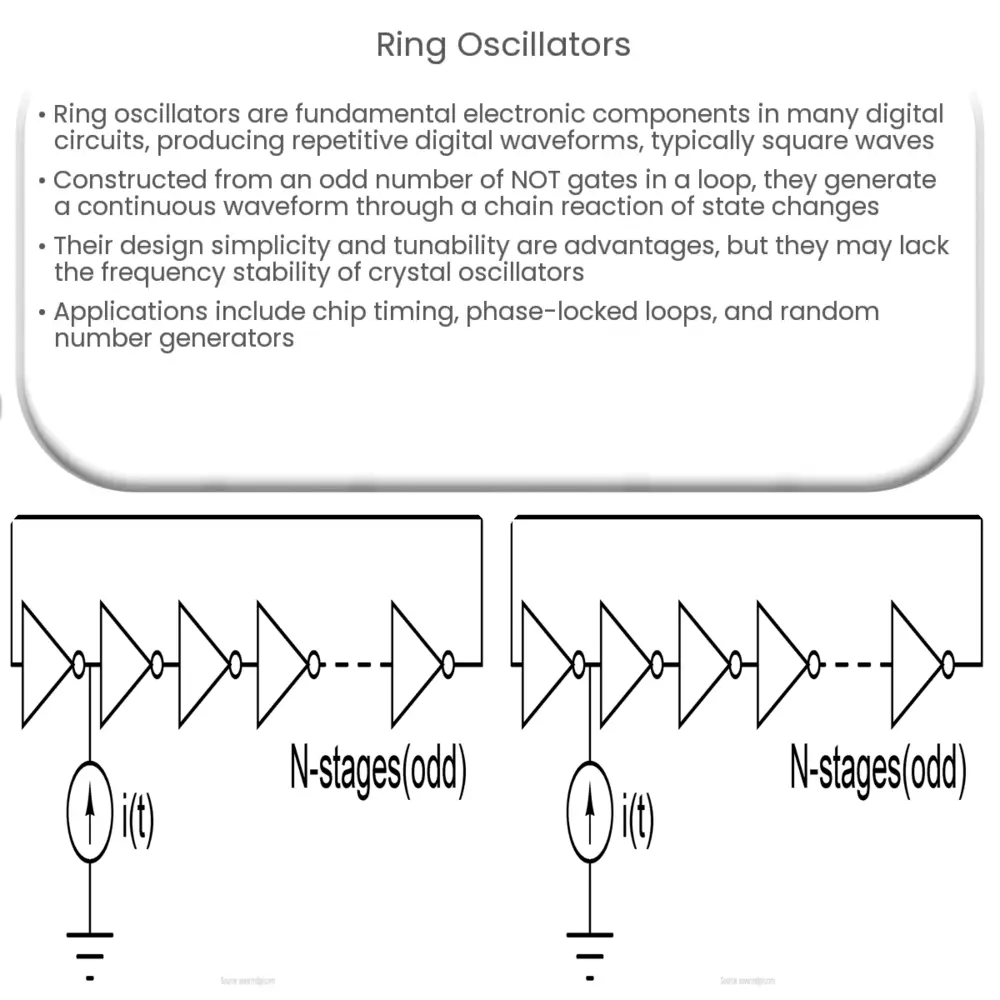Explore the intriguing world of ring oscillators – their structure, operation, advantages, limitations, and varied applications in modern electronics.

Understanding Ring Oscillators
A ring oscillator is a vital and simple electronic component found in a multitude of digital circuits. Ring oscillators are often used as a source of a repetitive digital waveform, usually a square wave. They are also used in applications that require frequency or phase comparison, and even as entropy sources in some types of random number generators.
Ring oscillators are constructed from an odd number of NOT gates or inverters in a loop. The state of each gate in the ring changes in response to the state of the gate before it, creating a chain reaction of state changes that move continuously around the ring. This results in a continuous, repetitive waveform that can be tapped from any point in the ring.
The Structure of Ring Oscillators
-
The basic building block of a ring oscillator is the inverter, a device that reverses its input.
-
The number of stages in a ring oscillator is the number of inverters in the ring. The number of stages must be odd to ensure that the oscillator can oscillate. With an even number of stages, the circuit would simply stabilize at a fixed state.
-
The feedback path of the ring oscillator is what creates the oscillation. The output from the final stage in the ring feeds back into the first stage, creating a continuous loop of state changes.
Operation of Ring Oscillators
The operational principle of the ring oscillator is deceptively simple. When power is applied to the circuit, each inverter changes state in response to the state of the inverter before it. Because the output of the final inverter feeds back into the first inverter, the state changes continue to propagate around the ring indefinitely.
This process results in an output waveform that is essentially a square wave with a frequency determined by the number of inverters and the propagation delay of each inverter. The period of this waveform, measured in seconds per cycle, is equal to twice the product of the number of inverters (n) and the propagation delay (d).
Advantages and Disadvantages of Ring Oscillators
Ring oscillators offer several advantages which make them appealing for a variety of applications. One of these advantages is their simplicity. Ring oscillators are easy to design and implement, and their operation is straightforward to understand.
Another benefit is their inherent tunability. The frequency of the output waveform can be adjusted by modifying the number of inverters in the ring or by changing the propagation delay of each inverter.
However, ring oscillators also have their limitations. The output frequency can be influenced by environmental factors like temperature and power supply variations. In addition, the frequency stability of a ring oscillator is often less than that of a crystal oscillator. This limits their use in applications where frequency stability is paramount.
Applications of Ring Oscillators
Despite these limitations, ring oscillators find utility in numerous applications:
-
Chip Timing: In the field of microelectronics, ring oscillators are used as on-chip clock sources. They can also be used to measure process variations in integrated circuit fabrication.
-
Phase-Locked Loops (PLLs): Ring oscillators are an essential component of PLLs, a control system that generates an output signal whose phase is related to the phase of an input signal.
-
Random Number Generators: Due to the inherent randomness of their frequency, ring oscillators are often used as the entropy source in hardware random number generators.
Conclusion
Ring oscillators are an integral part of modern electronic design due to their simplicity and wide range of applications. Their ability to produce a constant frequency output with an easily adjustable frequency makes them an invaluable tool for engineers and designers. While they have their limitations, their benefits and broad utility more than compensate for these drawbacks, reinforcing their essential role in the realm of electronics.

